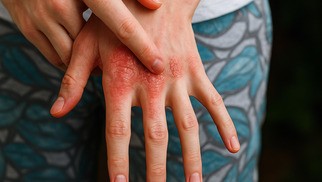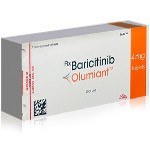Atopic Dermatitis: Causes, Symptoms, and Treatment Options


Atopic dermatitis (AD), also known as atopic eczema, is a chronic, relapsing inflammatory skin disorder that severely impacts quality of life. Affecting around 15% to 20% of children and up to 10% of adults globally, AD is considered one of the most common skin diseases. It leads to persistent itching, sleep disturbances, emotional distress, and an increased risk of skin infections. While its hallmark feature is intense pruritus (itching), AD encompasses a spectrum of signs and symptoms that vary across age groups and skin types.
Understanding Atopic Dermatitis
The pathogenesis of AD is complex and multifactorial, with genetic, immunologic, and environmental elements contributing to its onset and severity. A key genetic factor is mutations in the filaggrin gene, which disrupts the structure and function of the skin barrier. This makes the skin more permeable to allergens, irritants, and microbes, triggering chronic inflammation and recurrent disease flares.
Beyond the genetic component, AD is characterized by immune system dysregulation, predominantly involving T-helper 2 (Th2) cell-mediated responses. Cytokines such as IL-4, IL-13, and IL-31 play pivotal roles in promoting skin barrier dysfunction, inflammation, and itch.
Environmental factors further exacerbate the condition. Harsh climates, pollution, detergents, soaps, emotional stress, and even food allergens can provoke flare-ups. Patients with AD often experience comorbid atopic conditions, including asthma and allergic rhinitis, underlining the systemic nature of the atopic diathesis.
Recent research has also revealed the critical role of the skin microbiome. Patients with AD have altered microbial diversity with predominant colonization by Staphylococcus aureus, which worsens inflammation and pruritus. Understanding these pathogenic mechanisms has opened new therapeutic possibilities.
Typical Presentation of Atopic Dermatitis
AD presents differently depending on age. In infants, it usually starts within the first six months of life, manifesting as red, scaly patches on the cheeks, forehead, scalp, and extensor surfaces. In childhood, lesions become more localized to flexural areas such as the neck, elbows, wrists, and knees. Adolescents and adults often have chronic, thickened plaques with increased pigmentation, predominantly on the hands, feet, eyelids, and around the nipples.
Patients experience cycles of remission and exacerbation. The persistent itch-scratch cycle leads to lichenification (thickened, leathery skin), secondary bacterial infections, and psychological stress. In darker skin tones, AD may appear as dark brown, purple, or gray patches, which can lead to underdiagnosis and delays in treatment.
Complications such as eczema herpeticum (herpes simplex virus infection of eczematous skin) and molluscum contagiosum are more frequent due to impaired barrier and immune responses.
The Five Pillars of Atopic Dermatitis Management
Management of AD focuses on five interrelated principles:
- Restoring skin barrier function through the frequent use of bland emollients and moisturizers. This step reduces transepidermal water loss and protects against environmental insults.
- Controlling skin inflammation using topical corticosteroids and nonsteroidal agents like calcineurin inhibitors. Newer agents such as crisaborole, a phosphodiesterase-4 inhibitor, provide additional topical options.
- Alleviating pruritus, which can be achieved with systemic antihistamines, though their use is controversial due to limited efficacy. Behavioral therapies and wet-wrap treatments also reduce scratching behavior.
- Preventing and managing secondary infections. Staphylococcus aureus colonization is extremely common in AD and requires careful hygiene, topical antiseptics, or antibiotics in cases of overt infection.
- Identifying and avoiding triggers, including allergens, irritants, psychological stress, and infections. Individualized counseling and lifestyle modifications help minimize flares.
Importantly, patient and caregiver education is a cornerstone of effective treatment. Teaching proper skincare routines, recognizing early signs of flare, and understanding treatment options empower patients and significantly reduce disease burden.
Treatment Options for Atopic Dermatitis
Therapy is guided by disease severity. Mild AD is typically managed with emollients and low-potency topical steroids. For moderate-to-severe cases, medium- to high-potency topical corticosteroids, calcineurin inhibitors (such as tacrolimus or pimecrolimus), and phototherapy (narrowband UVB) may be employed.
Systemic immunosuppressants like cyclosporine, methotrexate, azathioprine, and mycophenolate mofetil have long been used for refractory cases but carry significant side effects and require close monitoring.
Biologic therapy has brought transformative change. Dupilumab, a monoclonal antibody against the IL-4 receptor alpha subunit, has shown profound efficacy and safety in patients with moderate-to-severe AD. However, injectable biologics may not suit every patient, highlighting the need for effective oral alternatives.
The Role of Olumiant in Treating Atopic Dermatitis
Olumiant (baricitinib), an oral Janus kinase (JAK) 1/2 inhibitor, is a breakthrough treatment for adults with moderate-to-severe AD who are inadequately controlled with conventional therapies. JAK inhibitors target intracellular signaling pathways involved in cytokine-mediated inflammation, providing a more focused and effective anti-inflammatory response.
Clinical trials have demonstrated that Olumiant significantly improves Eczema Area and Severity Index (EASI) scores, reduces pruritus, and enhances patients’ quality of life. In many cases, rapid symptomatic relief occurs within the first few weeks of therapy.
Olumiant’s oral administration offers a convenient alternative to injectables. Common side effects include upper respiratory tract infections, elevated cholesterol levels, headaches, and mild gastrointestinal disturbances. Rare but serious risks such as thrombosis and serious infections necessitate careful patient selection and regular laboratory monitoring.
Baricitinib is not approved for use in pediatric populations, and its safety during pregnancy and breastfeeding has not been fully established. It remains a valuable addition to the therapeutic arsenal for adult patients with refractory AD, offering hope and improved daily functioning.
Conclusion
Atopic dermatitis is a complex, burdensome disease requiring a tailored and multidisciplinary approach to care. While no permanent cure exists, a combination of skin barrier restoration, anti-inflammatory treatments, infection control, itch relief, and patient education can dramatically improve symptoms and minimize disease flares.
The emergence of targeted treatments such as Olumiant signals a paradigm shift in AD management. Future directions include continued research into the skin microbiome, identification of new therapeutic targets, and development of safer, more effective long-term treatments. As our understanding of the disease deepens, the goal of truly personalized medicine for atopic dermatitis draws ever closer, offering renewed hope for patients and clinicians alike.
Medically Reviewed by Dr. Faride Ramos, MD
(Updated at May 13 / 2025)

